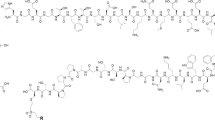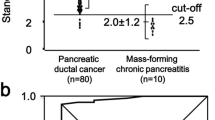Abstract
Introduction
Previous studies demonstrated that the lactose-binding protein (hepatocellular carcinoma–intestine–pancreas and pancreatitis-associated proteins (HIP/PAP)) is upregulated >130 times in peritumoral pancreatic tissue as compared to normal pancreatic tissue. Therefore, we developed a new radiolabeled ligand of HIP/PAP, the ethyl-β-d-galactopyranosyl-(1,4′)-2′-deoxy-2′-[18F]fluoro-β-d-glucopyranoside (Et-[18F]FDL) for noninvasive imaging of pancreatic carcinoma using positron emission tomography and computerized tomography (PET/CT).
Methods
The novel precursor and radiolabeling methods for synthesis of Et-[18F]FDL produced no isomers; the average decay-corrected radiochemical yield was 68%, radiochemical purity >99%, and specific activity >74 GBq/µmol. The radioligand properties of Et-[18F]FDL were evaluated using an ex vivo autoradiography and immunohistochemistry in pancreatic tissue sections obtained from mice-bearing orthotopic pancreatic tumor xenografts.
Results and Discussion
Et-[18F]FDL binding to peritumoral pancreatic tissue sections strongly correlated with HIP/PAP expression (r = 0.81) and could be completely blocked by treatment with 1 mM lactose.
Conclusion
These results suggest that Et-[18F]FDL is a promising agent which should be evaluated for detection of early pancreatic carcinomas by PET/CT imaging.



Similar content being viewed by others
References
Jemal A, Murray T, Samuels A, Ghafoor A, Ward E, Thun MJ (2003) Cancer statistics. CA Cancer J Clin 53:5–26
Poston GJ, Williamson RC (1990) Causes, diagnosis, and management of exocrine pancreatic cancer. Compr Ther 16:36–42
Brentnall TA, Bronner MP, Byrd DR, Haggitt RC, Kimmey MB (1999) Early diagnosis and treatment of pancreatic dysplasia in patients with a family history of pancreatic cancer. Ann Intern Med 131:247–255
Goggins M, Canto M, Hruban R (2000) Can we screen high-risk individuals to detect early pancreatic carcinoma? J Surg Oncol 74:243–248
Honda K, Hayashida Y, Umaki T, Okusaka T, Kosuge T, Kikuchi S, Endo M, Tsuchida A, Aoki T, Itoi T, Moriyasu F, Hirohashi S, Yamada T (2005) Possible detection of pancreatic cancer by plasma protein profiling. Cancer Res 65:10613–10622
Yokoi K, Shih LC, Kobayashi R, Koomen J, Hawke D, Li D, Hamilton SR, Abbruzzese JL, Coombes KR, Fidler IJ (2005) Serum amyloid A as a tumor marker in sera of nude mice with orthotopic human pancreatic cancer and in plasma of patients with pancreatic cancer. Int J Oncol 27:1361–1369
Rosty C, Christa L, Kuzdzal CS, Balwin WM, Zahurak ML, Carnot F, Cham DW, Canto M, Lillemoe KD, Cameron JL, Yeo CJ, Hruban RH, Goggins M (2002) Identification of hepatocarcinoma–intestine–pancreas/pancreatitis-associated protein I as a biomarker for pancreatic ductal adenocarcinoma by protein biochip technology. Cancer Res 62:1868–1875
Yamaguchi K, Enjoji M, Nakashima M, Nakamuta M, Watanabe T, Tanaka M (2005) Novel serum tumor marker, RCAS1, in pancreatic diseases. World J Gastroenterol 11:5199–5202
Fukushima N, Koopmann J, Sato N, Prasad N, Carvalho R, Leach SD, Hruban RH, Goggins M (2005) Gene expression alterations in the non-neoplastic parenchyma adjacent to infiltrating pancreatic ductal adenocarcinoma. Mod Pathol 18:779–787
Lasserre C, Colnot C, Brechot C, Poirier F (1999) HIP/PAP gene, encoding a C-type lectin overexpressed in primary liver cancer, is expressed in nervous system as well as in intestine and pancreas of the postimplantation mouse embryo. Am J Pathol 154:1601–1610
Christa L, Felin M, Morali O, Simon MT, Lasserre C, Brechot C, Seve AP (1994) The human HIP gene, overexpressed in primary liver cancer encodes for a C-type carbohydrate binding protein with lactose binding activity. FEBS Lett 337:114–118
Bormans G, Verbrugen A (2001) Enzymatic synthesis and buiodistribution in mice of β-O-d-galactopyranosyl-(1-4′)-2-[18F]fluoro-2′deoxy-d-glucopyranose (2′-[18F]fluorodeoxy-lactose). J Labelled Comp Radiopharm 44:417–423
Yun M, Chun KH, Shin JE, Oh J (2002) Synthesis of ethyl-β-d-galactopyranosyl-(1-4)-2-deoxy-2-fluoro-b-d-glucopyranoside. Bull Korean Chem Soc 23:177–178
Crich D, Li W, Li H (2004) Direct chemical synthesis of the beta-mannans: linear and block syntheses of the alternating beta-(1→3)-beta-(1→4)-mannan common to Rhodotorula glutinis, Rhodotorula mucilaginosa, and Leptospira biflexa. J Am Chem Soc 126:15081–15086
Bruns CJ, Harbison MT, Kuniyasu H, Eue I, Fidler IJ (1999) In vivo selection and characterization of metastatic variants from human pancreatic adenocarcinoma by using orthotopic implantation in nude mice. Neoplasia 1:50–62
Acknowledgements
This work was supported by start-up funds of Drs. Juri G. Gelovani and Mian M. Alauddin from The University of Texas, MD, USA, Anderson Cancer Center.
Author information
Authors and Affiliations
Corresponding author
Rights and permissions
About this article
Cite this article
Ying, Y., Ghosh, P., Guo, L. et al. Synthesis and Ex Vivo Autoradiographic Evaluation of Ethyl-β-d-galactopyranosyl-(1,4′)-2′-deoxy-2′-[18F]fluoro-β-d-glucopyranoside—A Novel Radioligand for Lactose-Binding Protein: Implications for Early Detection of Pancreatic Carcinomas with PET. Mol Imaging Biol 13, 536–546 (2011). https://doi.org/10.1007/s11307-010-0334-9
Published:
Issue Date:
DOI: https://doi.org/10.1007/s11307-010-0334-9




